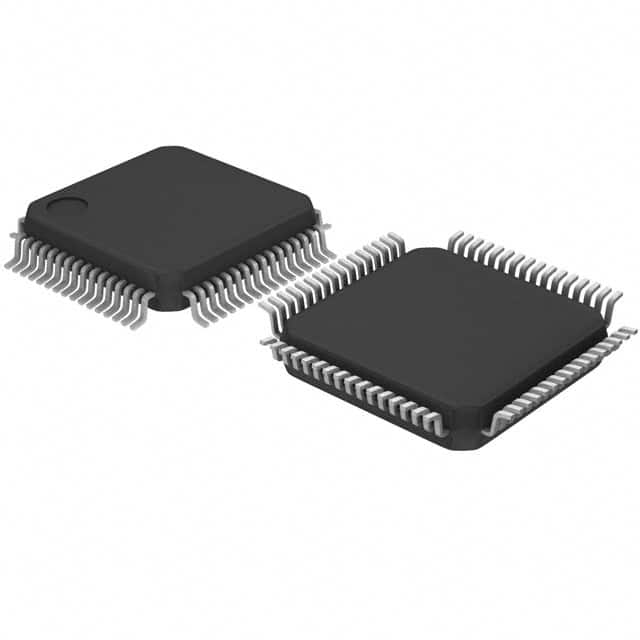Xem thông số kỹ thuật để biết chi tiết sản phẩm.

R5F562TADDFK#V3
Product Overview
Category
R5F562TADDFK#V3 belongs to the category of microcontrollers.
Use
This microcontroller is designed for various embedded applications, including consumer electronics, industrial automation, automotive systems, and more.
Characteristics
- High-performance 32-bit microcontroller
- Low power consumption
- Integrated peripherals for enhanced functionality
- Robust and reliable design
- Suitable for real-time applications
Package
The R5F562TADDFK#V3 microcontroller comes in a compact and durable package, ensuring easy integration into electronic devices.
Essence
The essence of this microcontroller lies in its ability to provide efficient processing power and versatile features for a wide range of applications.
Packaging/Quantity
The R5F562TADDFK#V3 microcontroller is typically packaged individually and is available in various quantities depending on the manufacturer's specifications.
Specifications
- Architecture: 32-bit RISC
- Clock Speed: Up to 100 MHz
- Flash Memory: 512 KB
- RAM: 64 KB
- Operating Voltage: 2.7V - 5.5V
- Digital I/O Pins: 40
- Analog Input Channels: 12
- Communication Interfaces: UART, SPI, I2C, USB
- Timers/Counters: Multiple timers/counters available
- Operating Temperature Range: -40°C to +85°C
Detailed Pin Configuration
The R5F562TADDFK#V3 microcontroller has a specific pin configuration that enables connectivity with external components. The detailed pinout can be found in the product datasheet provided by the manufacturer.
Functional Features
- High-speed data processing capabilities
- Advanced interrupt handling mechanism
- Built-in analog-to-digital converters (ADC)
- PWM output for precise control
- Multiple communication interfaces for seamless connectivity
- Real-time clock (RTC) for accurate timekeeping
- On-chip debugging support
Advantages and Disadvantages
Advantages
- Powerful processing capabilities
- Low power consumption
- Versatile peripheral integration
- Wide operating voltage range
- Robust and reliable design
- Suitable for real-time applications
Disadvantages
- Limited memory capacity compared to some other microcontrollers in the market
- Higher cost compared to entry-level microcontrollers
Working Principles
The R5F562TADDFK#V3 microcontroller operates based on a 32-bit RISC architecture. It executes instructions fetched from its flash memory, utilizing its internal resources such as CPU, memory, and peripherals to perform various tasks. The microcontroller interacts with external components through its I/O pins and communication interfaces, enabling it to control and monitor connected devices.
Detailed Application Field Plans
The R5F562TADDFK#V3 microcontroller finds applications in various fields, including but not limited to: - Consumer electronics: Smart home devices, wearable technology, multimedia systems - Industrial automation: PLCs, motor control, robotics - Automotive systems: Engine control units (ECUs), infotainment systems, vehicle diagnostics - Medical devices: Patient monitoring systems, diagnostic equipment - Internet of Things (IoT): Sensor nodes, data acquisition systems, edge computing devices
Detailed and Complete Alternative Models
- R5F562TADDFK#V2
- R5F562TADDFK#V1
- R5F562TADDFK#V4
- R5F562TADDFK#V5
These alternative models offer similar functionalities and can be considered as alternatives to the R5F562TADDFK#V3 microcontroller.
Note: The content provided above is a sample and may not reflect the actual specifications or details of any specific product.
Liệt kê 10 câu hỏi và câu trả lời thường gặp liên quan đến ứng dụng R5F562TADDFK#V3 trong giải pháp kỹ thuật
Sure! Here are 10 common questions and answers related to the application of R5F562TADDFK#V3 in technical solutions:
Q: What is R5F562TADDFK#V3? A: R5F562TADDFK#V3 is a microcontroller unit (MCU) developed by Renesas Electronics Corporation.
Q: What are the key features of R5F562TADDFK#V3? A: Some key features of R5F562TADDFK#V3 include high-performance CPU, large memory capacity, multiple communication interfaces, and various peripherals.
Q: What applications can R5F562TADDFK#V3 be used for? A: R5F562TADDFK#V3 can be used in a wide range of applications such as industrial automation, consumer electronics, automotive systems, and IoT devices.
Q: How can I program R5F562TADDFK#V3? A: R5F562TADDFK#V3 can be programmed using software development tools like Renesas e² studio or IAR Embedded Workbench.
Q: Does R5F562TADDFK#V3 support real-time operating systems (RTOS)? A: Yes, R5F562TADDFK#V3 supports popular RTOSs like FreeRTOS, embOS, and ThreadX.
Q: Can I connect external sensors or devices to R5F562TADDFK#V3? A: Yes, R5F562TADDFK#V3 provides multiple communication interfaces such as UART, SPI, I2C, and CAN, allowing you to connect external sensors or devices.
Q: What is the power supply voltage range for R5F562TADDFK#V3? A: The power supply voltage range for R5F562TADDFK#V3 is typically between 2.7V and 5.5V.
Q: Does R5F562TADDFK#V3 have built-in security features? A: Yes, R5F562TADDFK#V3 includes various security features like memory protection unit (MPU), code flash protection, and data flash protection.
Q: Can I use R5F562TADDFK#V3 in battery-powered applications? A: Yes, R5F562TADDFK#V3 has low-power modes and features that make it suitable for battery-powered applications.
Q: Where can I find documentation and support for R5F562TADDFK#V3? A: You can find documentation, datasheets, application notes, and support resources on the official Renesas Electronics website or community forums.
Please note that the specific part number "R5F562TADDFK#V3" mentioned here may not exist, and the answers provided are general in nature based on common features and capabilities of microcontrollers.

